By We Level Up NJ Treatment Center | Editor Yamilla Francese | Clinically Reviewed By Lauren Barry, LMFT, MCAP, QS, Director of Quality Assurance | Editorial Policy | Research Policy | Last Updated: January 3, 2023
Prazosin Uses & Guide
Prazosin has been proven to be safe and effective in the management of nightmares and sleep disturbances associated with PTSD and is indicated where these distressing symptoms are present. It has been shown, in several published studies, to significantly reduce nightmares and improve sleep in patients suffering from PTSD.
What is prazosin used to treat? Prazosin nightmares PTSD medication has shown effectiveness in treating Post-Traumatic Stress Disorder by improving sleep quality. Given the significant evidence for its utility in treating PTSD, in combination with the fact that many anxiety symptoms overlap with PTSD (e.g.insomnia, hyperarousal, and irritability), it is essential to evaluate its potential effectiveness in treating symptoms of other anxiety disorders and patient tolerability. [1]
Furthermore, prazosin is used alone or in combination with other medications to treat high blood pressure. This medication is in a class of medications called alpha-blockers. It works by relaxing the blood vessels so that blood can flow more quickly through the body.
Unfortunately, like other drugs, it may cause severe side effects, withdrawal, and substance abuse risks. Abuse of this drug is also a concern, as it has been a prescription drug on the market since 1988. Although it’s effective in treating symptoms associated with mental illness, many rehab centers are diving into its side effects and potential for abuse.
Some of the Prazosin off label uses include Post-traumatic stress disorder, nightmares, Raynaud’s phenomenon, pheochromocytoma, scorpion envenomation, and benign prostatic hypertrophy.
Prazosin Uses
Prazosin is combined with or independently from other medicines to manage elevated blood pressure. The reduction of high blood pressure aids in the prevention of strokes, heart attacks, and kidney complications. Classified as an alpha blocker, Prazosin operates by inducing relaxation and dilation of blood vessels, thereby facilitating smoother blood flow.
How To Use Prazosin
Administer this medicine orally, with or without food, following your doctor’s instructions, usually twice or thrice daily. If you experience stomach discomfort, consume it with food or milk. The prescribed dose hinges on your age, medical condition, and response to treatment.
Prazosin may infrequently lead to sudden fainting following the initial dose or whenever your dosage is elevated. To mitigate the risk of fainting, your doctor will initiate treatment with the smallest available dose. Take this initial dose before going to bed to minimize the likelihood of fainting. As your dosage may be incrementally raised, take the first newly adjusted dose at bedtime unless otherwise directed by your doctor.
Consistently use this medication to derive maximum benefits. Take it at the same time(s) daily for easy remembrance. If you use it to manage high blood pressure, continue even if you feel well. Most individuals with high blood pressure don’t experience symptoms. It might take several weeks before the full effects of this medication become apparent.
Do not discontinue usage without consulting your doctor. Abruptly stopping the drug could exacerbate certain conditions. Gradual dosage reduction might be necessary.
Prazosin Side Effects
During your body’s acclimatization to the medication, you might experience headaches, drowsiness, fatigue, weakness, blurred vision, nausea, vomiting, diarrhea, or constipation. If these effects persist or worsen, promptly inform your doctor or pharmacist.
Lightheadedness or dizziness upon standing, particularly after the initial dose or shortly after taking a dose within the first week of treatment, may also manifest. Rise gradually from a seated or lying position to mitigate the risk of dizziness and potential fainting. Should dizziness arise, promptly sit or lie down. Your dosage might need adjustment.
Remember that your doctor has prescribed this medication because they have determined that the benefits outweigh the potential side effects. Serious side effects are uncommon among users of this medication.
If you encounter any severe side effects, such as a pounding heartbeat, fainting, frequent urination, or mental/mood changes (like depression), or if you notice swelling of the feet/ankles, notify your doctor immediately.
In rare instances, males may experience a painful or prolonged erection lasting 4 hours or more. If this occurs, discontinue the medication and seek immediate medical assistance, as failure to do so could result in lasting complications.
Experiencing a highly severe allergic reaction to this medication is uncommon. Nonetheless, seek medical assistance promptly if you observe any signs of a severe allergic reaction, such as a rash, itching, swelling (particularly of the face, tongue, or throat), pronounced dizziness, or difficulty breathing.
This compilation does not encompass all potential side effects. If you encounter other effects not outlined here, contact your doctor or pharmacist.
Prazosin Risks
Before initiating prazosin, inform your doctor or pharmacist if you are allergic to it, other alpha-blockers (like doxazosin or terazosin), or any other allergies. Inactive ingredients within this product could trigger allergic reactions or other complications. For more detailed information, consult your pharmacist.
Before commencing this medication, disclose your medical history to your doctor or pharmacist, particularly if you have a history of heart issues (such as low blood pressure), kidney disease, uncontrolled narcoleptic episodes, prostate cancer, or particular eye conditions (cataracts, glaucoma).
This medication may induce dizziness, drowsiness, or blurred vision. The consumption of alcohol or marijuana (cannabis) could intensify these effects. Refrain from driving, operating machinery, or engaging in activities requiring alertness or clear vision until you can do so safely. Abstain from driving or participating in hazardous tasks for 24 hours after your initial dose, any dosage increase, or recommencement of treatment. If your doctor introduces additional blood pressure medications, avoid driving and hazardous activities for 24 hours following your first dose of the new medication. Consume alcoholic beverages in moderation. Consult your doctor if you are using marijuana (cannabis).
Exercise caution when standing for extended durations to mitigate the likelihood of dizziness and fainting. Prevent overheating during physical activity and hot weather. When beginning this medication, avoid situations where fainting might lead to injury.
Before undergoing surgery, including procedures like cataract/glaucoma eye surgery, inform your doctor or dentist about your current or past use of this medication and all other products you are using (including prescription and nonprescription drugs, as well as herbal products).
Elderly individuals might display greater susceptibility to the side effects of this medication, particularly dizziness and fainting. These effects could heighten the potential for falls.
While pregnant, it’s advisable to use this medication only if necessary. Have a conversation with your doctor about the potential risks and benefits.
Prazosin is excreted into breast milk. Before breastfeeding, consult your doctor for guidance.
Prazosin Interactions
Interactions between drugs can alter the functioning of your medications or elevate the risk of severe side effects. This document does not encompass all feasible drug interactions. Compile a comprehensive list of all the items you are using, including prescription and nonprescription drugs and herbal products, and share it with your doctor and pharmacist. Do not initiate, cease, or modify the dosage of any medications without the explicit approval of your doctor.
Certain products may interact with this medication, such as other alpha-blocker drugs (like doxazosin and terazosin), beta-blockers (such as atenolol, metoprolol, propranolol), and drugs employed for treating erectile dysfunction (ED) or pulmonary hypertension (like sildenafil, tadalafil).
Inform your doctor or pharmacist if you are consuming other items that induce drowsiness, such as opioid pain or cough relievers (such as codeine, hydrocodone), alcohol, marijuana (cannabis), medications for sleep or anxiety (like alprazolam, lorazepam, zolpidem), muscle relaxants (such as carisoprodol, cyclobenzaprine), or antihistamines (like cetirizine, diphenhydramine).
Since some products may include components that lead to drowsiness, thoroughly review the labels of all your medications, including allergy or cough-and-cold products. Seek guidance from your pharmacist on the safe use of these products.
Certain items encompass ingredients that could potentially elevate heart rate or blood pressure. Inform your pharmacist about the substances you use and inquire about safe usage methods, especially cough-and-cold products, diet aids, or nonsteroidal anti-inflammatory drugs (NSAIDs) such as ibuprofen or naproxen.
This medication can potentially disrupt specific laboratory tests (such as the pheochromocytoma screening test), which could lead to inaccurate test outcomes. Ensure that both laboratory staff and all your medical practitioners know about your medication usage.
Prazosin Overdose
In case of a Prazosin overdose, your immediate action is crucial. If the person is experiencing severe symptoms like loss of consciousness or difficulty breathing, dial 911 immediately. If symptoms are less severe, contact a poison control center right away.
Prazosin Imprints
Below is a dosage chart providing information about Prazosin dosage ranges, imprints, color, shape, and tablet versus capsule classification.
| Dosage Range (mg) | Imprint | Color | Shape | Type |
|---|---|---|---|---|
| 1 | GPI 1mg 084 | White | Oblong | Capsule |
| 2 | GPI 2 mg 085 | Pink & White | Oblong | Capsule |
| 5 | 021 novitium | Light Blue & Light Brown | Oblong | Capsule |
Common Questions Relating To Prazosin Hydrochloride Uses
-
Does prazosin calm you down?
Yes. Chronic treatment with this drug lessens concurrent anxiety-like behavior and alcohol intake.
-
Does prazosin help with anxiety?
Yes. Daytime pretreatment with this drug reduced psychological distress, specifically to trauma cues. Adding daytime medication to the bedtime dose may reduce overall PTSD illness severity and distress.
-
What is prazosin hydrochloride used for?
If you are wondering, “what is prazosin hcl used for?”, the answer is that prazosin is used to treat high blood pressure either alone or in combination with other medications (hypertension). The workload on the heart and arteries is increased by high blood pressure. The heart and arteries may not work correctly if it persists for a long time.
What Is Prazosin Prescribed For?
Many doctors also prescribe this medication off-label to treat PTSD-associated nightmares. This means that the Food and Drug Administration (FDA) has not approved it for this purpose, but it may still help reduce PTSD nightmares.
This antihypertensive drug controls high blood pressure but does not cure it. Continue to take this medication even if you feel well. Please do not stop taking it without talking to your doctor.
Prazosin comes as a capsule to take by mouth. The proper use of prazosin usually is by taking it two or three times a day at evenly spaced intervals. You should take this medication the first time before you go to bed. Follow the uses for prazosin directions on your prescription label carefully, and ask your doctor or pharmacist to explain any part you do not understand. Take prazosin exactly as directed.
Prazosin drug is also used to treat benign prostatic hyperplasia (BPH, noncancerous enlargement of the prostate), congestive heart failure, pheochromocytoma (adrenal gland tumor), sleep problems associated with post-traumatic stress disorder (PTSD; an anxiety disorder in people who experience or witness a traumatic, life-threatening event), and Raynaud’s disease (a condition where the fingers and toes change skin color from white to blue to red when exposed to hot or cold temperatures).
Talk to your doctor about the possible prazosin interactions and risks of using this medication for your condition. Your doctor will probably start you on a low dose of prazosin and gradually increase your dose.
Prazosin for Mental Health
What does prazosin do? Prazosin pill affects the actions of the brain chemical norepinephrine (noradrenaline). Norepinephrine influences blood pressure, heart rate, and anxiety in the body, but it also affects sleep and arousal. This medication stabilizes certain brain areas, making them “less excited.” This improves symptoms of PTSD, such as nightmares and sleep disturbances.
Side effects may be more common when starting a medication
or after a dose increase. Talk to your doctor, nurse or
pharmacist if any side effect concerns you:
- Prazosin dizziness and drowsiness
- Low blood pressure
- Headache
- Nausea
Prazosin is not addictive. People do not get “cravings” for this medication like they might with nicotine or street drugs. But if you and your doctor decide you should stop taking this medication, your doctor will explain how to come off it safely. This is crucial to avoid the adverse effects as your body adjusts to being without it.
Some people also mix prazosin and alcohol, prazosin and Benadryl, or even a mix of prazosin and trazodone. these are dangerous combinations. Mixing it with other drugs and drinking alcohol while taking this medication increases the risk of dangerously low blood pressure. Contact your care team immediately if you experience dizziness, faintness, lightheadedness, or blurry vision.
What is prazosin used for in mental health?
This drug has been proven safe and effective in managing nightmares and sleep disturbances associated with PTSD and is indicated where these distressing symptoms are present.
How much does prazosin lower blood pressure?
An initial 1mg of this medication is used with or without other medications to treat high blood pressure. Lowering high blood pressure helps prevent strokes, heart attacks, and kidney problems.

Skip To:
- Prazosin Uses
- What Is Prazosin Prescribed For?
- Prazosin for Mental Health
- Prazosin Overdose Death Statistics
- Prazosin Mechanism of Action Facts Sheet
- Prazosin Medication for Nightmares
- How Does Prazosin Work For PTSD?
- Prazosin for Insomnia
- Side Effects Prazosin Symptoms
- Prazosin Abuse
- Prazosin High
- Prazosin Withdrawal Symptoms & Drug Detox
- Dual Diagnosis Treatment for PTSD & Drug Abuse
- Top 20 Prazosin Medication Frequently Asked Questions
Learn More:
Get Help. Get Better. Get Your Life Back.
Searching for Accredited Drug & Alcohol Rehab Centers Near You? Or Mental Health Support?
Even if you have failed previously, relapsed, or are in a difficult crisis, we stand ready to support you. Our trusted behavioral health specialists will not give up on you. Call us when you feel ready or want someone to speak to about therapy alternatives to change your life. Even if we cannot assist you, we will lead you wherever you can get support. There is no obligation. Call our hotline today.
FREE Addiction Hotline – Call 24/7Prazosin Overdose Death Statistics
The most significant adverse effect is the ‘first dose effect’ syncope with a sudden loss of consciousness (1%) with an initial dose of at least 2 mg. Hence, a patient should always be started at prazosin 1mg. Some of the common side effects of prazosin tablets are the following:
- Dizziness (10%)
- Headache (8%)
- Drowsiness (8%)
- Lack of energy (7%)
- Weakness (7%)
- Palpitations (5%)
- Nausea (5%)
In less than 1% of patients taking this medication, abdominal discomfort/pain, tachycardia, paresthesias, hallucinations, pruritus, incontinence, impotence, and priapism have been reported. [2]
5-10%
Common side effects of this antihypertensive medication in 5 to 10% of patients are dizziness, headaches, drowsiness, lack of energy, weakness, palpitations, and nausea.
Source: NCBI
2 mg
The most significant adverse effect is the ‘first dose effect’ syncope with the sudden loss of consciousness (1%) with an initial dose of at least 2 mg.
Source: NCBI
3rd
Adverse prescription drug effects and other medical errors are the third leading cause of death in America – just behind cancer and heart disease.
Source: NCBI
Prazosin Mechanism of Action
(Prazosin MOA) Facts Sheet
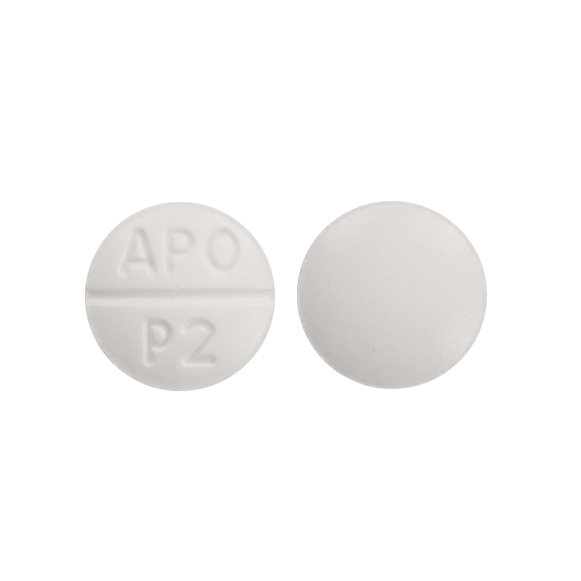
Prazosin Doses
- Prazosin 1 mg capsule – Used alone or with other medicines to treat high blood pressure (hypertension).
- Prazosin 2 mg capsule – Your doctor may gradually increase your dosage, but it should always start with 1 mg as the prazosin 2mg capsules’ initial take may cause sudden loss of consciousness.
- Prazosin 5 mg – 1-5 mg orally twice daily; may increase the dose to 20 mg/day in divided doses. This prazosin max dose should be medically supervised.
- Prazosin HCL 1mg capsule – Adults initially take prazosin HCL 1 mg caps orally every 8-12 hours.
Prazosin Goodrx Availability: Generic & Brand. Also available as:
- Prazosin 1 mg tablet
- Prazosin hydrochloride 2 mg
- Prazosin HCL 2mg capsule
Prazosin Drug Class
It is a synthetic piperazine derivative and an alpha-1 adrenergic receptor inhibitor.
Prazosin Class: It belongs to a class of medicines called antihypertensives.
Prazosin Half Life: The elimination half-life is about 2.5 hours.
prazosin Brand Names: Minipress, Prazin, and Prazo
Prazosin Generic Name: Generic prazosin is available with no other name besides its brands.
Prazosin Other Names: Commonly known as Minipress
Prazosin Pronunciation: It’s pronounced as “praa·zow·zn”
Prazosin Minipress: (prazosin hydrochloride) is an alpha-adrenergic blocker used to treat hypertension (high blood pressure).
Prazosin Pregnancy Category: The FDA assigned Prazosin-polythiazide to pregnancy category C. There are no good studies on prazosin in pregnancy. It should be used during pregnancy only if the possible benefit outweighs the possible risk to the unborn baby.
Is Prazosin: A Controlled Substance?
It is not a controlled medication. Controlled substances include opioids, stimulants, depressants, hallucinogens, and anabolic steroids.
Warnings
The most common adverse reactions were postural hypotension, dizziness, headache, drowsiness, lack of energy, weakness, palpitations, and nausea.
Prazosin Nightmares
Prazosin is recommended when PTSD-related nightmares and sleep problems are present because it has been shown to be both safe and effective in managing these distressing symptoms. It has been demonstrated in several peer-reviewed studies to significantly lessen nightmares and enhance sleep in PTSD patients.
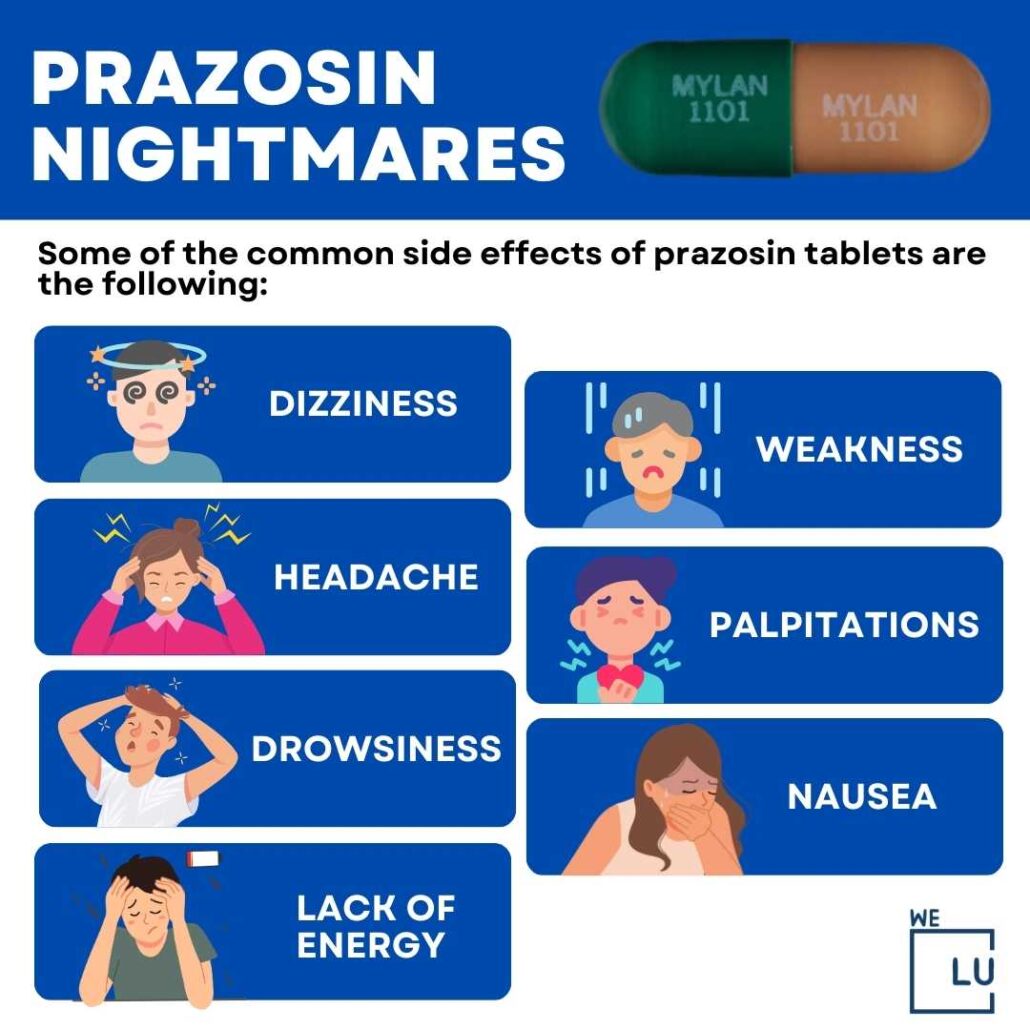
Embed the above “Prazosin Nightmares” Infographic to your Website. This infographic is provided by the We Level Up addiction treatment center team. To use the above infographics, you agree to link back and attribute its source and owner at https://welevelupnj.com/addiction/prazosin/
Prazosin Nightmares image link: https://welevelupnj.com/wp-content/uploads/2023/05/Prazosin-Nightmares-1030×1030.jpg
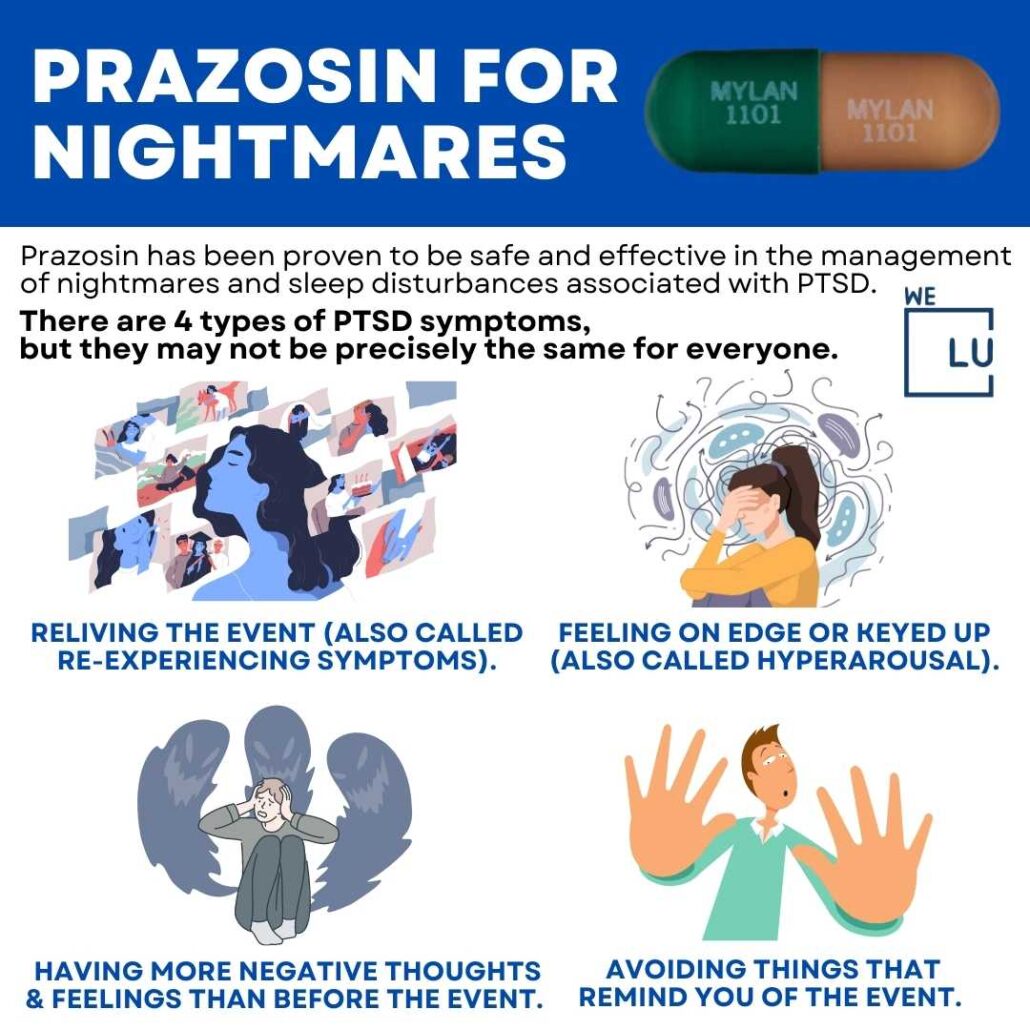
Embed the above “Prazosin for Nightmares” Infographic to your Website. This infographic is provided by the We Level Up addiction treatment center team. To use the above infographics, you agree to link back and attribute its source and owner at https://welevelupnj.com/addiction/prazosin/
Prazosin for Nightmares image link: https://welevelupnj.com/wp-content/uploads/2023/05/Prazosin-For-Nightmares-1030×1030.jpg
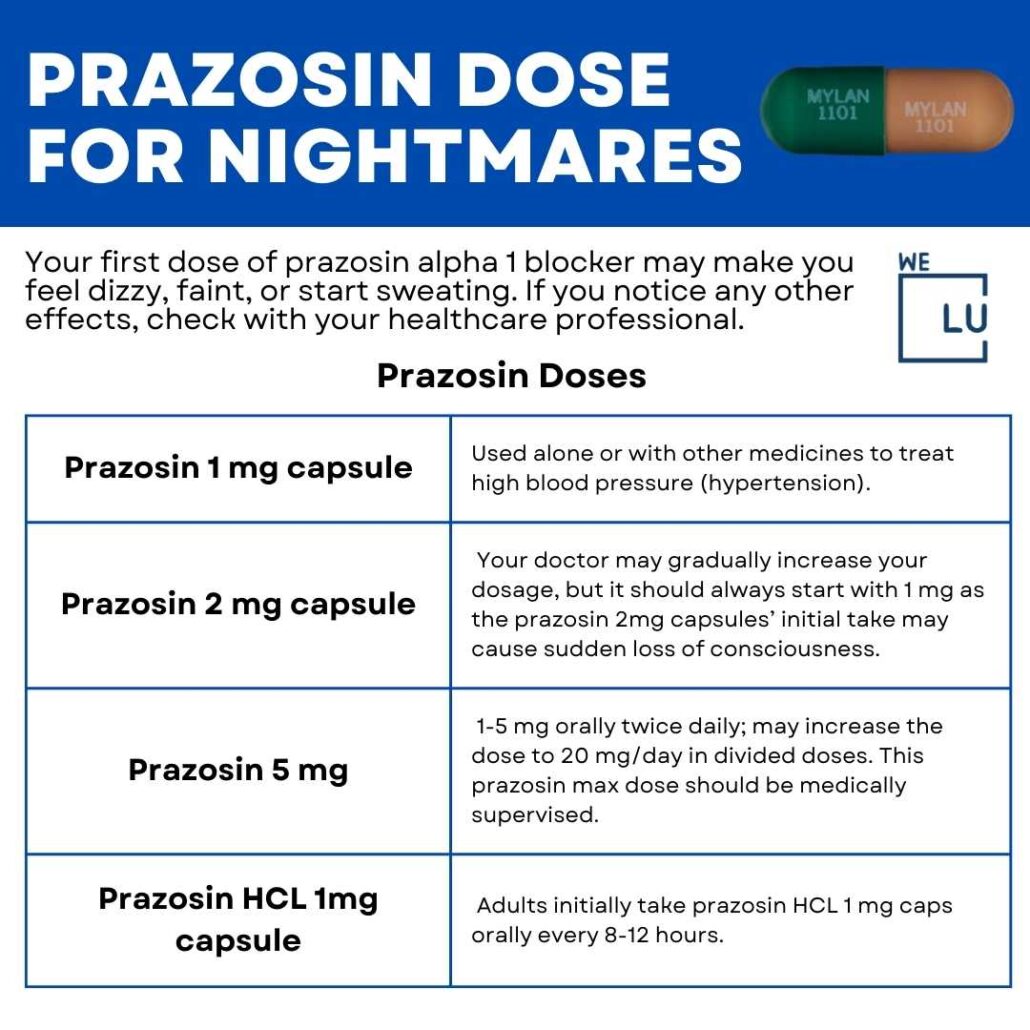
Embed the above “Prazosin Dose for Nightmares” Infographic to your Website. This infographic is provided by the We Level Up addiction treatment center team. To use the above infographics, you agree to link back and attribute its source and owner at https://welevelupnj.com/addiction/prazosin/
Prazosin Dose for Nightmares image link: https://welevelupnj.com/wp-content/uploads/2023/05/Prazosin-Dose-for-Nightmares-1030×1030.jpg

Get Your Life Back
Find Hope & Recovery. Get Safe Comfortable Detox, Addiction Rehab & Mental Health Dual Diagnosis High-Quality Care at the We Level Up Treatment Centers Network.
Hotline (877) 378-4154Prazosin Medication for Nightmares
In several published studies, this medication has been shown to significantly reduce nightmares and improve sleep in patients suffering from PTSD. [3] Nightmares are inherently distressing, prevent restorative sleep, and are associated with several psychiatric problems. Nightmares are highly dysphoric dreams involving intense negative emotions primarily present during late-night rapid eye movement (REM) sleep. About one in 20 of the general population experiences nightmares every week. In contrast, estimates of the prevalence of nightmares are far higher for psychiatric populations. [4]
Prazosin Used for Nightmares
Prazosin dose for nightmares is a lipid-soluble α1-adrenergic receptor antagonist that crosses the blood-brain barrier and decreases the sympathetic outflow in the brain. It has been approved by the US Food and Drug Administration for the treatment of hypertension. Still, it is seldom used today as an antihypertension medication because of the numerous other preferred antihypertension drugs available.
However, prazosin dosage for nightmares has been studied off-label for treating trauma-associated nightmares. It has been recommended for treating PTSD-associated nightmares, with a level A recommendation supported by high-quality evidence.
Based on VA-associated studies and diffusion of knowledge, awareness of prazosin for PTSD nightmares is increasing. The 2010 Veterans Administration (VA)/Department of Defense Clinical Practice Guideline for Management of Post-Traumatic Stress recommends that clinicians provide prazosin 1 mg for nightmares to treat sleep disorders and nightmares with a level B strength of recommendation, based on at least fair evidence that the intervention improves health outcomes and that benefits outweigh the harm. [5]

Dose of Prazosin for Nightmares
The highest reported prazosin dosage for PTSD is 16 mg daily. Furthermore, prazosin for PTSD dose 16 mg was well tolerated and beneficial for the pharmacologic treatment of alcohol dependence. A patient can start with the medication at 1 mg at bedtime for the first three days and then increase it to 2 mg at bedtime and rest for 4 days. The dose could be titrated to 16 mg if patients fail to respond and the adverse reactions are tolerable.
Alternatives to Prazosin for Nightmares
Doctors commonly prescribe it for high blood pressure but may prescribe it off-label to reduce PTSD nightmares. However, prazosin for nightmares side effects includes dizziness, weakness, heart palpitations, and nausea. Other effective treatments for PTSD nightmares include CBT and IRT.
CBT or Cognitive Behavioral Therapy
CBT is a type of talk therapy that focuses on how people think and interpret events in their life. During a CBT session, a therapist will work with a patient to explore and develop methods to deal with specific challenges and behaviors. Studies show that CBT can be an effective treatment for helping manage PTSD symptoms, including sleep disturbances.
IRT or Imagery Rehearsal Therapy
IRT is a form of cognitive behavioral therapy (CBT). During IRT, a therapist will provide the individual with background information about sleep and nightmares. This can help a person manage their nightmares. The individual then works closely with their therapist to create nonfrightening endings for the nightmares they experience. They can write down these endings and rehearse them mentally.
IRT also helps a person learn how to monitor their nightmares to understand how effective the therapy is.
Side Effects of Prazosin for Nightmares
Some side effects of prazosin for nightmares dosage may occur that usually do not need medical attention. These side effects may disappear during treatment as your body adjusts to the medicine. Also, your healthcare professional may be able to tell you about ways to prevent or reduce some of these side effects. Check with your health care professional if any of the following side effects continue or are bothersome or if you have any questions about them.
Side Effects & Symptoms
More Common
- Headache
- Lack of energy
- Unusual drowsiness, dullness, or feeling of sluggishness
Less Common
- Bloody nose
- Diarrhea
- Discouragement
- Dry mouth
- A feeling of constant movement of self or surroundings
- Feeling sad or empty
- Increased need to urinate
- Loss of interest or pleasure
- Nervousness
- Passing urine more often
- Sensation of spinning
- Stuffy nose
- Trouble concentrating
- Trouble sleeping
Rare
- Burning, crawling, itching, numbness, prickling, “pins and needles,” or tingling feelings
- Continuing ringing or buzzing or other unexplained noise in the ears
- Difficulty in moving
- Hearing loss
- Increased sweating
- Loss or thinning of the hair
- Muscle pain or stiffness
- Pain in the joints
- Seeing, hearing, or feeling things that are not there
Other side effects not listed may also occur in some patients. If you notice any other effects, check with your healthcare professional.
Side Effects on Urination
These drugs block the ability of the nervous system to tighten certain types of muscles found in the bladder and blood vessels. As a result, these muscles relax, lowering blood pressure in people with hypertension, allowing more blood flow in people with Raynaud’s, and allowing urine to flow more freely out of the bladder for people with an enlarged prostate.
It may cause fluid retention, but the drug does not appear to affect renal function or renin secretion. (a hormone secreted by the juxtaglomerular cells of the kidney; the renin-angiotensin-aldosterone system is primarily associated with blood pressure regulation by modulating blood volume, sodium reabsorption, potassium secretion, water reabsorption, and vascular tone.)
Prazosin Side Effects Weight Gain
Weight gain and prazosin side effects weight loss is not typical. Although the treatment for your high blood pressure may include weight control and changes in the types of foods you eat, especially foods high in sodium (salt). Your doctor will tell you which of these is most important for you. You should check with your doctor before changing your diet.
Other Warnings:
If you have cataracts and need surgery, be aware that this drug may increase your risk for complications during surgery, known as intraoperative floppy iris syndrome (IFIS). If you need eye surgery, let your doctor know that you’re taking this medication. The doctor may give you medications before surgery or perform the surgery using different techniques to help decrease your risk for IFIS.
Prazosin Side Effects Blood Pressure
It works by relaxing the blood vessels so that blood passes through them more easily. This helps to lower blood pressure. This medication may also be used for other conditions as determined by your doctor.
Significant side effects of the drug in blood pressure may happen when your doctor does not supervise your dosage or if you don’t follow the instructions. The most common adverse reaction is postural hypotension.
Postural hypotension—or orthostatic hypotension— is when your blood pressure drops from lying down to sitting up or from sitting to standing. When your blood pressure drops, less blood can go to your organs and muscles. This can make you more likely to fall.
Prazosin Side Effects Erectile Dysfunction
The early-generation drugs (eg, terazosin and prazosin) are also antihypertensive medications and thus have the same problem as all antihypertensive. They decrease blood flow to the penis and therefore worsen erectile dysfunction.
The drug may also cause priapism (prolonged erections). If you have an erection lasting more than four hours, call your doctor or seek emergency medical help immediately. If this isn’t treated, it may result in erectile dysfunction or tissue scarring.
How long do prazosin side effects last?
As the body adapts to the drug, many side effects will improve. If they don’t, most will go away when the drug is discontinued. With a half-life of between two and three hours, this drug is rapidly cleared from the body. So most mild side effects will dissipate even in the case of a missed dose.
Does prazosin make you gain weight?
Weight gain is not a typical side effect of the drug. Although the treatment for your high blood pressure may include weight control and changes in the types of foods you eat, especially foods high in sodium (salt). Your doctor will tell you which of these is most important for you. You should check with your doctor before changing your diet.
First-class Facilities & Amenities
World-class High-Quality Addiction & Mental Health Rehabilitation Treatment
Rehab Centers TourRenowned Addiction Centers. Serene Private Facilities. Inpatient rehab programs vary.
Addiction Helpline (877) 378-4154Proven recovery success experience, backed by a Team w/ History of:
15+
Years of Unified Experience
100s
5-Star Reviews Across Our Centers
10K
Recovery Success Stories Across Our Network
- Low Patient to Therapist Ratio
- Onsite Medical Detox Center
- Comprehensive Dual-Diagnosis Treatment
- Complimentary Family & Alumni Programs
- Coaching, Recovery & Personal Development Events
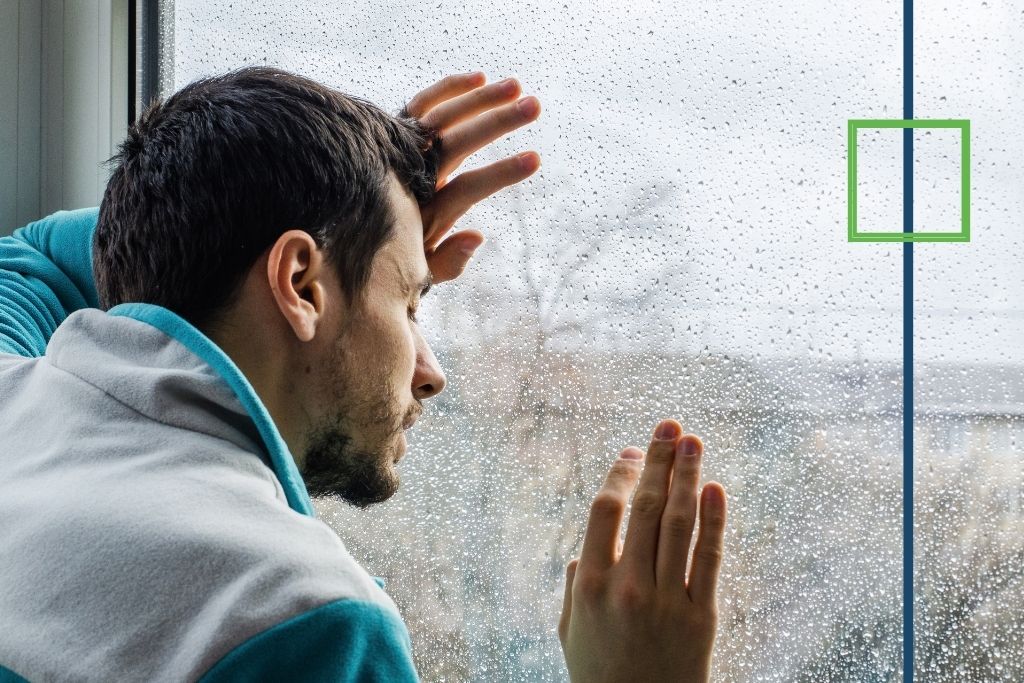
How Does Prazosin Work For PTSD?
Posttraumatic stress disorder (PTSD) is a psychiatric disorder with symptoms that include insomnia due to hyperarousal and recurring nightmares. These symptoms are believed to be due to a conditioned response regulated by norepinephrine. Prazosin, an α1 antagonist, can decrease levels of norepinephrine in the central nervous system, thereby reducing nightmares related to PTSD.
Posttraumatic stress disorder (PTSD) often follows a chronic course, and the disorder is resistant to treatment with antidepressants and cognitive-behavioral therapy in many patients. PTSD medication prazosin, an a1-adrenoceptor blocker, has shown some promise in treating chronic PTSD. [6]
Prazosin and PTSD have also been studied in younger and older adults with PTSD and patients with alcohol problems, in whom it was found to reduce cravings and stress responses. Prazosin HCL for PTSD offers some hope for treating resistant cases of PTSD in which recurrent nightmares are problematic, with a relatively rapid response within weeks. It is suggested that large-scale civilian trials of prazosin mental health uses be done, as well as studies concerning the use of prazosin classification in acute PTSD and as a potential preventive agent.
World-class, Accredited, 5-Star Reviewed, Effective Addiction & Mental Health Programs. Complete Behavioral Health Inpatient Rehab, Detox plus Co-occuring Disorders Therapy.
CALL (877) 378-4154End the Addiction Pain. End the Emotional Rollercoaster. Get Your Life Back. Start Drug, Alcohol & Dual Diagnosis Mental Health Treatment Now. Get Free No-obligation Guidance by Substance Abuse Specialists Who Understand Addiction & Mental Health Recovery & Know How to Help.
Prazosin for Insomnia
Thousands of people with post-traumatic stress disorder have taken prazosin for sleep dosage to ease the nightmares and disturbances that hunt their sleep. Numerous studies have shown the drug to be effective at controlling those episodes.
It can take up to 8 weeks to see the full benefits. When prazosin for sleep dose works well, you may notice a reduction of nightmares and improved sleep. You must continue taking prazosin dosage for sleep regularly, even if you are feeling well or there are no improvements in the first few weeks. Some conditions may become worse when the drug is abruptly stopped.
Does prazosin help you sleep?
Yes. This medication can significantly increase total sleep time and REM sleep time compared with the placebo effects of other sleeping aid treatments.
Prazosin Abuse
Many individuals with PTSD have turned to this medication as an alternative to other sleep aids and sedatives with a higher potential for abuse and addiction. However, misuse and abuse of this drug are possible and are characterized by using more than the dose prescribed.
Prazosin for anxiety dosage and PTSD medication users are just as much at risk of suffering from adverse side effects when misusing this medication as when using any other drug. Liver disease and different types of damage to the organs and workings of the body can result from misusing any medication. Always be cautious when taking any medications prescribed to you, and avoid taking ones that are not.
Experience Transformative Recovery at the We Level Up Treatment Center.
See our authentic success stories. Get inspired. Get the help you deserve.



Start a New Life
Begin with a free call to an addiction & behavioral health treatment advisor. Learn more about our dual-diagnosis programs. The We Level Up treatment center network delivers various recovery programs at each treatment facility. Call to learn more.
- Personalized Care
- Caring Accountable Staff
- World-class Amenities
- Licensed & Accredited
- Renowned w/ 5-Star Reviews
We’ll Call You
Prazosin High
Can prazosin make you high? No. If you take too much of this medication, you may experience a significant drop in blood pressure, with symptoms such as extreme dizziness. lightheadedness. fainting. This drug is not addictive and not a controlled substance.
Nonetheless, this drug may not be as life-threatening as other drugs of abuse like benzodiazepines, opioids, heroin, cocaine, and meth. However, this drug can still produce adverse side effects and withdrawal symptoms.
Can you get high off prazosin?
No. But it is hazardous to misuse this drug. If you take too much, you may experience a significant drop in blood pressure, with symptoms such as extreme dizziness. lightheadedness. fainting.
Prazosin Withdrawal Symptoms & Drug Detox
This type of medication is used for long-term treatment. It comes with serious risks if you don’t take it as prescribed. If you stop taking the drug and your blood pressure stays too high, it can put you at risk of severe health problems such as heart attack and stroke.
Do not stop taking this medication without first consulting your doctor. Some conditions may become worse when the drug is abruptly stopped. Your dose may need to be gradually decreased. Tell your doctor if your condition worsens (such as your routine blood pressure readings increase). Most patients experience a recurrence of insomnia and nightmares upon prazosin discontinuation.
The fastest-growing drug problem in the United States isn’t cocaine, heroin, or methamphetamines. It is prescription drug addiction that profoundly affects the lives of many old and young individuals.
A common misperception is that prescription drugs are safer or less harmful to one’s body than other drugs. However, there is a range of short- and long-term health consequences for each prescription drug used inappropriately.
Fortunately, there are a variety of evidence-based approaches to treating addiction and mental health problems. Drug abuse treatment can incorporate behavioral therapy (cognitive-behavioral therapy or contingency management), medications, or a combination. The specific treatment or combination of treatments will range depending on the client’s individual needs and, often, on the drugs they use.
Many treatment programs exercise both individual and group therapies. For instance, group therapy can provide social reinforcement and help enforce behavioral contingencies that promote abstinence and a non-drug-using lifestyle.
Drug misuse is a complex issue that requires long-term treatment – not a quick fix. Therefore, the first step in drug abuse treatment is to seek help from your medical provider or a trained professional. Clearing drugs from the body and overcoming withdrawal symptoms is the goal of a medical detox, which is the first step of drug abuse treatment.

Dual Diagnosis Treatment for PTSD & Drug Abuse
An integrated dual diagnosis approach will usually involve a combination of treatment modalities, including individual therapy, group therapy, family therapy, psycho-education, and pharmacotherapy. Psycho-education helps reduce the anxiety and distress associated with PTSD.
General physical signs of addiction include but are not limited to:
- Enlarged or small pupils
- Sudden weight loss or gain
- Bloodshot eyes
- Insomnia
- Unusual body odors
- Poor physical coordination
- Looking unkempt
- Slurred speech
Typical signs of an overdose may include but are not limited to:
- Drowsiness or trouble walking
- Agitation
- Aggression or violent behavior
- Difficulty breathing
- Nausea and vomiting
- Hallucinations
- Delusions
- Loss of consciousness
There are 4 types of PTSD symptoms, but they may not be precisely the same for everyone. Each person experiences symptoms in their way.
- Reliving the event (also called re-experiencing symptoms). Memories of the traumatic event can come back at any time. They can feel genuine and scary. For example:
- You may have nightmares.
- You may feel like you are going through the event again. This is called a flashback.
- You may see, hear, or smell something that causes you to relive the event. This is called a trigger. News reports, seeing an accident, or hearing fireworks are examples of triggers.
- Avoiding things that remind you of the event. You may avoid situations or people that remind you of the trauma event. You may even avoid talking or thinking about the event. For example:
- You may avoid crowds because they feel dangerous.
- You may avoid driving if you were in a car accident or if your military convoy was bombed.
- If you were in an earthquake, you might avoid watching movies about earthquakes.
- You may keep very busy or avoid getting help, so you don’t have to think or talk about the event.
- Having more negative thoughts and feelings than before the event. How you think about yourself and others may become more damaging because of the trauma. For example:
- You may feel numb—unable to have positive or loving feelings toward other people—and lose interest in things you used to enjoy.
- You may forget about parts of the traumatic event or not be able to talk about them.
- You may think the world is dangerous and no one can be trusted.
- You may feel guilt or shame about the event, wishing you had done more to keep it from happening.
- Feeling on edge or keyed up (also called hyperarousal). You may be jittery or always alert and on the lookout for danger. You might suddenly become angry or irritable. For example:
- You may have a hard time sleeping.
- You may find it hard to concentrate.
- You may be startled by a loud noise or surprise.
- You might act unhealthy, like smoking, abusing drugs or alcohol, or driving aggressively.
People with PTSD are more prone to violent outbursts and panic attacks, which can be difficult for family and friends to witness. Feelings of guilt over these outbursts can drive those with PTSD to self-medicate with drugs and alcohol. Continued use of alcohol or other drugs in this way can lead to addiction.
We Level Up NJ’s thorough approach to rehabilitation supports several levels of care to ensure the best possible outcome for every client who enters our doors. From an intensive and more supportive atmosphere for those in the early days of recovery to a comfortable residential-style living dynamic upon completion of detox, we are here to help guide you down the safe and results-based path to your sobriety. Once detox is complete, a new doorway in dual diagnosis treatment opens up, referred to as a residential level of care to help the clients uncover the cause of drug abuse and receive PTSD therapies.
We Level Up NJ residential care program slowly and effectively introduces the individual into an atmosphere of therapeutic growth, marked by Master’s level therapists, clinicians, group counselors, psychiatrists, and a community of like-minded individuals with the same aim: to attain sobriety and live a great life.
Clients in residential therapy programs will live comfortably within the facility during this crucial and fragile time. This supportive environment is designed to give clients 24-hour care for sobriety, removing temptations for relapse and applying an air of recovery into every component of the treatment timeline.
We Level Up NJ finds that clients living in a supportive community, especially during their early recovery, can genuinely focus on what matters most: their recovery. Make this your opportunity to reclaim your life with a comfortable drug addiction treatment. Call today to speak with one of our treatment specialists.
Top Prazosin Medication Frequently Asked Questions
-
Can prazosin cause a false positive drug test?
Yes. But it depends. False positive results may occur in screening tests for pheochromocytoma in patients treated with this drug. Pheochromocytoma is a type of neuroendocrine tumor that grows from chromaffin cells. These cells produce hormones needed for the body and are found in the adrenal glands. The adrenal glands are small organs located in the upper region of the abdomen on top of the kidneys.
-
How much prazosin is lethal?
Any higher dosage, or more than what was prescribed, can be lethal with its side effects.
-
Is prazosin a beta blocker?
No. This medication is in a class of drugs called alpha-blockers. It works by relaxing the blood vessels so that blood can flow more quickly through the body.
-
Can you OD on prazosin?
Yes, you can overdose on this drug. This medication comes as a capsule under Minipress or Minizide brand name and is often used alone or in combination to treat high blood pressure.
-
What does prazosin do for PTSD?
This medication has been proven safe and effective in managing nightmares and sleep disturbances associated with PTSD and is indicated where these distressing symptoms are present.
-
Is prazosin a controlled substance?
It is not a controlled medication. Controlled substances include opioids, stimulants, depressants, hallucinogens, and anabolic steroids.
-
How to pronounce prazosin?
It’s pronounced as “praa·zow·zn.”
-
How long does it take prazosin to work for nightmares?
It can take up to 8 weeks to see the full benefits. When the Prazosin nightmares dose works well, you may notice a reduction of nightmares and improved sleep. You must continue taking the drug regularly, even if you are feeling well or there are no improvements in the first few weeks.
-
How does prazosin work for nightmares?
This drug is considered sufficiently lipophilic to cross the blood-brain barrier and antagonize the α1 receptors in the CNS, blocking these stress responses. Through this mechanism, this medication can improve sleep and reduce nightmares associated with PTSD.
-
Is prazosin a sleeping pill?
This medication is not typically for helping with sleep, although some people with PTSD-related sleep problems have found that they sleep better when taking it.
Search We level Up NJ Prazosin Drug Detox & Mental Health Topics & Resources
Sources
[1] Prazosin Reviews in Adults With Anxiety Disorders – U.S. National Institutes of Health U.S. Department of Health and Human Services
[2] Koola MM, Varghese SP, Fawcett JA. High-dose prazosin PTSD dose for the treatment of post-traumatic stress disorder. Ther Adv Psychopharmacol. 2014 Feb;4(1):43-7. DOI: 10.1177/2045125313500982. PMID: 24490030; PMCID: PMC3896131.
[3] Hudson SM, Whiteside TE, Lorenz RA, Wargo KA. Prazosin nightmares dose related to posttraumatic stress disorder: a literature review. Prim Care Companion CNS Disord. 2012;14(2):PCC.11r01222. DOI: 10.4088/PCC.11r01222. Epub 2012 Mar 22. PMID: 22943034; PMCID: PMC3425466.
[4] Rek S, Sheaves B, Freeman D. Nightmares in the general population: identifying potential causal factors. Soc Psychiatry Psychiatr Epidemiol. 2017 Sep;52(9):1123-1133. DOI: 10.1007/s00127-017-1408-7. Epub 2017 Jul 15. PMID: 28712041; PMCID: PMC5581821.
[5] Kung S, Espinel Z, Lapid MI. Treatment of nightmares: a systematic review. Mayo Clin Proc. 2012 Sep;87(9):890-900. DOI: 10.1016/j.mayocp.2012.05.015. Epub 2012 Aug 9. PMID: 22883741; PMCID: PMC3538493.
[6] Green B. Prazosin HCL PTSD Treatment. J Psychiatr Pract. 2014 Jul;20(4):253-9. DOI: 10.1097/01.pra.0000452561.98286.1e. PMID: 25036580.
[7] Watkins LE, Sprang KR, Rothbaum BO. Treating PTSD: A Review of Evidence-Based Psychotherapy Interventions. Front Behav Neurosci. 2018 Nov 2;12:258. DOI: 10.3389/fnbeh.2018.00258. PMID: 30450043; PMCID: PMC6224348.
[8] Schrader C, Ross A. A Review of PTSD and Current Treatment Strategies. Mo Med. 2021 Nov-Dec;118(6):546-551. PMID: 34924624; PMCID: PMC8672952.
[9] Khalil H, Zeltser R. Antihypertensive Medications. [Updated 2022 May 15]. In: StatPearls [Internet]. Treasure Island (FL): StatPearls Publishing; 2022 Jan-. Available from: https://www.ncbi.nlm.nih.gov/books/NBK554579/
[10] Aronow WS. Antihypertensive drug therapy. Ann Transl Med. 2018 Apr;6(7):123. DOI: 10.21037/atm.2018.01.26. PMID: 29955583; PMCID: PMC6015954.